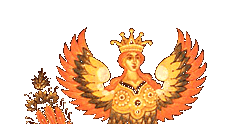Moscow Cathedrals, Museums, and Red Square
THE TRETYAKOV GALLERY
With only twelve days of actual time in Moscow, I wanted to make my days as effective as possible. I needed to accomplish certain work-related things, but also had a deep desire to wander about the city with just my camera and a supply of film. Luckily, business and pleasure found a way of meshing together in many instances. The first instance of this was our visit to the Tretyakov Gallery. I was unprepared for the treasures that lay inside the unassuming facade of one of Moscow's most prominent museums. As a graduate from San Diego State University who in Russian language and minored in Eastern European history, and during my time with Russian Sunbirds, I have been extensively exposed to Russian works of art--paintings, murals, icons, sculpture, avant-garde, etc. However, seeing them all in person was an altogether different experience.
Visiting the Tretyakov, a brash individual could reach out and touch "The Three Bogatyrs" or "The Appearance of Christ to the People", but to do so would ruin the magic of beholding them. As I roamed from hall to hall, I would discover myself to be in a Levitan wood, a Shishkin field, an Aivazovskiy sea, or on Red Square as the streltsy were brought out to be executed. Or I would turn and be face to face with Pushkin, Tolstoy, or the famous 'girl with peaches.' As if in a whirlwind, I journeyed on to stand watch with three bogatyrs, bathe a red horse, march with the peasants to the Kursk Governorship, and was there for the visitation of Christ to the people. This last piece, the 20-year culmination of the dream of artist Alexander Ivanov, especially caught my eye. The enormous canvas takes up a full wall of the room devoted especially to this masterful work. In this hall, and in a small room adjoining it, are the sketches and individual studies Ivanov used for each of the figures in the painting.
We went through the whole thing in a matter of a few hours, and I wish that I could have spent all week there. Not only was I looking at incredible works of art, but these were works of art that i was familiar with, and this was the ultimate bonding time. It was also very beneficial from a research point of view--I was able to find the originals we had been looking for of some Fedoskino and Mstera pieces we have in the office. It also prepared me for future pieces that we'll acquire.
A note on discrimination: visitors to Moscow should be prepared for preferential treatment in the form of higher prices for tickets to just about everywhere. This includes the museums, the Kremlin, and other attractions. Prices for foreigners are often ten times the Russian price.
RED SQUARE
No trip to Moscow would be complete without a visit to Red Square. This is the epitome of Russia. St. Basil's. GUM. Lenin's tomb. The Historical Museum. The Kremlin wall. This is the stuff of Moscow. The day we visited the historical square it was a cold and windy day. Compared to its hey-day as a central gathering point and the busy summer tourist season, Red Square was sparsely populated. A few foreigners taking pictures, and some Russian school groups.
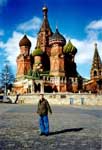 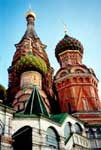 St. Basil's cathedral at first seemed small and unimpressive in person, after being glorified in picture and legend. But as I walked around it, I became humbled by this ancient structure. The aging red brick betrays the edifice's years, but that structure's walls have seen centuries of history unfold on the grey cobblestone beneath them. My awe gave way to a feeling of insignificance. Then a wave of awe swept over me again as I remembered the many exquisite miniature paintings of St. Basil's I have seen on lacquer boxes smaller than its red bricks. The renderings by skilled Fedoskino artists could be no higher in praise to the architects of this incredible landmark.
St. Basil's cathedral at first seemed small and unimpressive in person, after being glorified in picture and legend. But as I walked around it, I became humbled by this ancient structure. The aging red brick betrays the edifice's years, but that structure's walls have seen centuries of history unfold on the grey cobblestone beneath them. My awe gave way to a feeling of insignificance. Then a wave of awe swept over me again as I remembered the many exquisite miniature paintings of St. Basil's I have seen on lacquer boxes smaller than its red bricks. The renderings by skilled Fedoskino artists could be no higher in praise to the architects of this incredible landmark.
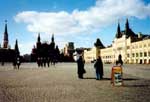 THE STATE PUSHKIN MUSEUM OF FINE ART
After my account of the Tretyakov Gallery, it seems unfair to spend any less time on the Pushkin Museum. A few days later, after an unsuccessful attempt at visiting the Kremlin, we headed down to this magnificent edifice. The entrance is much more stately than the Tretyakov, but the wonders inside are just as incredible. The Pushkin Museum has much more world art, and a respectable ancient civilizations collection. Unlike the Tretyakovs, who were collectors of Russian art in all its forms, the Pushkin Museum (established by the tsars then run by the government) has collected things from all over and by various means. What I personally liked about the museum was that it had paintings by some of my favorite artists--Van Gogh, Monet (especially Monet, I spent a lot of time in that room), and Picasso. After a satisfying cultural feast, we headed down to the small museum cafeteria to have a temporal feast.
CATHEDRAL OF CHRIST THE SAVIOR
If you've been to Russia before, this is actually something new. Unless you were around before the original structure's demolition in 1931. It was leveled to make way for an enormous new "Palace of the Soviets". Only trouble is that the historical cathedral was destroyed before Soviet engineers figured out that the enormity of the planned complex would not be supported by the floating bedrock below. The ground lay fallow while new designs were considered, and then through World War II. Finally in the 70s the grounds were converted into a massive heated outdoor swimming pool. Reconstruction of the cathedral was begun in 1994, and the interior frescoes were finished in December of 1999. The result is magnificent. The grounds are extensive, but in winter were not very impressive. Finding pictures online, I discovered that there are actually fountains surrounding the cathedral and it takes on a more beautiful aura.
THE STATE PUSHKIN MUSEUM OF FINE ART
After my account of the Tretyakov Gallery, it seems unfair to spend any less time on the Pushkin Museum. A few days later, after an unsuccessful attempt at visiting the Kremlin, we headed down to this magnificent edifice. The entrance is much more stately than the Tretyakov, but the wonders inside are just as incredible. The Pushkin Museum has much more world art, and a respectable ancient civilizations collection. Unlike the Tretyakovs, who were collectors of Russian art in all its forms, the Pushkin Museum (established by the tsars then run by the government) has collected things from all over and by various means. What I personally liked about the museum was that it had paintings by some of my favorite artists--Van Gogh, Monet (especially Monet, I spent a lot of time in that room), and Picasso. After a satisfying cultural feast, we headed down to the small museum cafeteria to have a temporal feast.
CATHEDRAL OF CHRIST THE SAVIOR
If you've been to Russia before, this is actually something new. Unless you were around before the original structure's demolition in 1931. It was leveled to make way for an enormous new "Palace of the Soviets". Only trouble is that the historical cathedral was destroyed before Soviet engineers figured out that the enormity of the planned complex would not be supported by the floating bedrock below. The ground lay fallow while new designs were considered, and then through World War II. Finally in the 70s the grounds were converted into a massive heated outdoor swimming pool. Reconstruction of the cathedral was begun in 1994, and the interior frescoes were finished in December of 1999. The result is magnificent. The grounds are extensive, but in winter were not very impressive. Finding pictures online, I discovered that there are actually fountains surrounding the cathedral and it takes on a more beautiful aura.
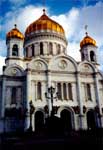 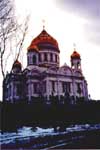 The interior is simply breathtaking. It's designed as one enormous hall, and I kept turning in circles as I kept noticing things I hadn't see the first 18 times I had looked that way. Of all the cathedrals in Moscow (besides those in the Kremlin), this is the one that should be visited. It's a majestic example of the tradition and also of the rebuilding that the Russian spirit is capable of. (www.xxc.ru/english/ is the cathedral's official web page if you'd like more information.)
ALL-RUSSIA MUSEUM OF DECORATIVE-APPLIED AND FOLK ART
This was the first and best lacquer box exhibit I visited in Moscow. The museum also contains a lot of other examples of Russian folk art, including clothing, rugs, porcelein and more that we didn't take the time to look at. We wanted the lacquer art! The collection includes some very old pieces, including rare works by Vishnyakov and Lukutin artists. There are also many pieces by artists still in their prime.
The interior is simply breathtaking. It's designed as one enormous hall, and I kept turning in circles as I kept noticing things I hadn't see the first 18 times I had looked that way. Of all the cathedrals in Moscow (besides those in the Kremlin), this is the one that should be visited. It's a majestic example of the tradition and also of the rebuilding that the Russian spirit is capable of. (www.xxc.ru/english/ is the cathedral's official web page if you'd like more information.)
ALL-RUSSIA MUSEUM OF DECORATIVE-APPLIED AND FOLK ART
This was the first and best lacquer box exhibit I visited in Moscow. The museum also contains a lot of other examples of Russian folk art, including clothing, rugs, porcelein and more that we didn't take the time to look at. We wanted the lacquer art! The collection includes some very old pieces, including rare works by Vishnyakov and Lukutin artists. There are also many pieces by artists still in their prime.
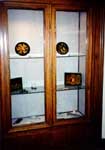 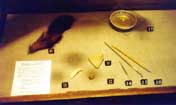 With the museum workers down the hall, I was able to get in a few photos, but they can't possibly do justice to the masterpieces behind the glass. The museum is a little ways off the main street, but when you find it, the small price of admission is well worth it.
With the museum workers down the hall, I was able to get in a few photos, but they can't possibly do justice to the masterpieces behind the glass. The museum is a little ways off the main street, but when you find it, the small price of admission is well worth it.
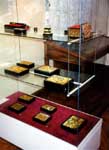 Click here for the next selection from the trip
Click here for the next selection from the trip
|

